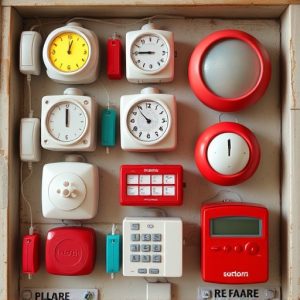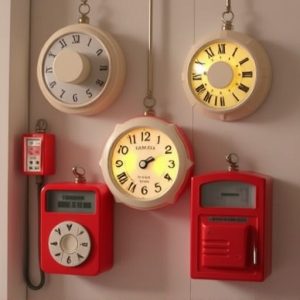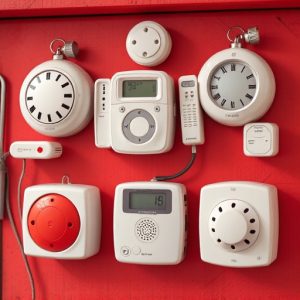Compact Personal Safety Devices: Decibels, Reach, and Legal Use
Personal alarms, designed to emit powerful 120-130 dB sounds, offer crucial protection in emergency…….
Personal alarms, designed to emit powerful 120-130 dB sounds, offer crucial protection in emergency situations, with an average clear range of 400 meters. However, urban environments or enclosed spaces reduce this range significantly due to sound absorption and interference. When selecting a compact personal safety alarm, key factors include decibel level (ideally 120-130 dB) and adjustable volume settings for optimal loudness in various scenarios. Legal considerations regarding sound range and decibel regulations vary by region and must be understood to avoid legal issues and ensure compliance with local laws.
Personal safety is paramount, especially in today’s diverse environments. Compact noise-making devices, often called personal alarms, offer a discrete yet powerful way to deter potential threats. This article explores the effectiveness of these devices, focusing on their sound output measured in decibels and reach. We’ll delve into different types, legal considerations, and best practices, providing insights to help you choose and use a personal alarm effectively for your safety.
- Understanding Personal Alarm Sounds: Decibels and Reach
- Types of Compact Noise Devices for Personal Safety
- Effectiveness: How Loud is Enough?
- Legal Considerations and Best Practices for Using Personal Alarms
Understanding Personal Alarm Sounds: Decibels and Reach
Personal alarm sounds are designed to be loud and attention-grabbing, but understanding their reach and decibel levels is crucial for effective personal safety. Decibels measure sound intensity, with higher numbers indicating louder sounds. Most personal alarms produce sounds in the range of 120 to 130 decibels. While this might seem intense, it’s important to note that the effectiveness of an alarm isn’t solely based on its volume. The key factor is how far the sound travels and how well it penetrates background noise.
The reach of a personal alarm sound can vary significantly depending on environmental conditions, such as outdoor vs. indoor settings, and distance from the source. On average, a personal alarm’s sound can be heard clearly up to 400 meters (about 1300 feet) in open spaces like parks or streets. However, this range decreases dramatically in cluttered urban environments or enclosed spaces like buildings or vehicles due to sound absorption and interference.
Types of Compact Noise Devices for Personal Safety
Personal safety is a top priority, and compact noise-making devices offer a convenient solution for those in need. These innovative tools come in various forms, each designed to emit powerful sounds that can deter potential threats and attract attention quickly. One of the most common types is the personal alarm, often in the form of a small, portable device that can be easily carried or attached to clothing or bags. These alarms are known for their piercing and loud noises, which can startle an assailant and create enough disturbance to alert nearby people. The effectiveness of these devices lies not only in their sound intensity but also in how far the noise travels; some models can produce sounds that are heard up to 100 feet away, ensuring maximum impact in emergency situations.
Another popular option is the pepper spray-equipped personal safety device, offering a non-lethal way to defend against attacks. These devices are typically compact and easily concealable, allowing users to carry them discreetly. When activated, they emit a powerful stream of pepper spray designed to cause temporary blindness and irritation, giving the user time to escape. While not as loud as traditional alarms, pepper spray can still create a commotion and signal for help, making it another effective compact personal safety tool.
Effectiveness: How Loud is Enough?
When considering a compact noise making personal safety device, one of the primary concerns is its effectiveness—how loud is enough? The sound level should be sufficient to startle an attacker and draw attention from passersby, ensuring immediate assistance arrives. Personal alarms typically emit sounds ranging from 120 to 130 decibels (dB). This volume is considered powerful enough to disrupt a potential attack, with the U.S. Food and Drug Administration (FDA) recommending personal alarms exceeding 120 dB for maximum effectiveness.
The range at which these devices can be heard effectively varies based on environmental factors such as noise levels in the surrounding area and weather conditions. Studies suggest that personal alarms can be heard clearly up to approximately 500 feet (or 150 meters) in ideal conditions. However, this distance may be reduced significantly in noisy urban environments or areas with high wind. Thus, choosing a device with an adjustable volume setting can enhance versatility, ensuring optimal loudness for diverse scenarios.
Legal Considerations and Best Practices for Using Personal Alarms
Personal alarms, designed to deter potential threats and draw attention, are a popular choice for personal safety devices. However, users must be aware of legal considerations when carrying and activating these devices. The range at which a personal alarm can be heard is a key factor; laws vary by region, but generally, personal alarms should be capable of emitting a sound loud enough to startle an attacker and alert nearby individuals. In some areas, there are specific decibel requirements for personal alarms to ensure their effectiveness without causing unnecessary disturbance.
Best practices dictate that users should only activate their personal alarm when genuinely threatened or in danger. Misuse can lead to legal repercussions and waste resources, as emergency services may be called unnecessarily. It’s crucial to familiarize yourself with local laws regarding the use of personal alarms and understand the specific requirements for decibel levels (How Far Personal Alarm Sounds) to ensure compliance and maximize safety.
Compact noise-making personal safety devices offer a practical solution for individuals seeking to protect themselves in various situations. By understanding the decibel levels and reach of these alarms, choosing the right type for specific needs, and considering legal aspects, users can ensure their safety effectively. The right personal alarm can make a significant difference in creating a safe space, with sounds powerful enough to deter potential threats and alert others nearby.


